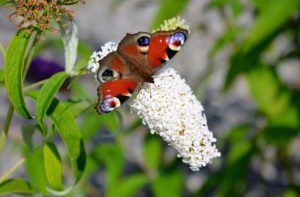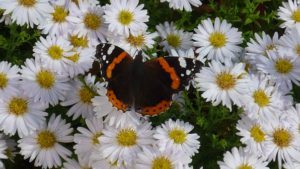Taking a closer look at the Red Admiral Butterfly

History of the red admiral butterfly
The red admiral butterfly belongs to the family Nymphalidae this beautiful butterfly can be found in places such as the Caribbean, Asia, both Central and North America, the island regions of Hawaii, North Africa, and Europe.
These butterflies can be easily identified with wings that are black with white spots and orange bands that make this butterfly so beautiful. They thrive in climates that are warm, from March through October in North America the red admiral has two broods each year.
During the spring the red admiral butterfly migrates north and may do so also during the fall months.
The male admiral is territorial and can be seen actively flying patrolling their marked area. Mating takes place in late autumn or early winter. The females, however, will only mate with males that have territory.
These butterflies are pretty amazing and also popular among garden butterflies. Below we will be looking at the life cycle along with some other interesting facts about the red admiral butterfly.
The red admiral habitat
The red admiral butterflies can be found in coastal areas, gardens, mountainous areas, forests, meadows, marshes, moist woods, fields, and parks.
The life cycle of the red admiral butterfly
After mating and when the time comes to give birth, the females lay their eggs singly on the host plants, the host plants are plants these butterflies prefer and their larva will feed on. Nettles are the preferred plant.
The eggs have a greenish color, once the egg hatches which is about 8-9 days the caterpillar which is a huge eater consumes the leaves very quickly that causes the caterpillar to grow rapidly over a 6 weeks period.
As the caterpillar enters the next stage raps itself with silk in the leave of the host plant forming a cocoon. Inside the chrysalis, a beautiful transformation takes place. Once the caterpillar goes through the final pupa stage in the summer a beautiful butterfly emerges.
Attracting the red admiral butterfly to your garden
1. Install plants that will attract them, some of these plants include.

2. Placing a shallow bowl of water will provide them with the water they need.
3. A few rocks will provide a place of rest for the.
4. A bowl of overripe fruits is a good treat for your garden friends.
5. Creating a mud puddle by simply keeping a part of the soil moist will not only provide butterflies with water but this is will help them to take up minerals.
6. A shallow bowl of sand and water will also provide them with the minerals they need.
12 Fun facts of the admiral butterfly
1. The red admiral has been known to fly fast.
2. These butterflies are well known.
3. They are people-friendly.
4. The red admiral has been known to land and perch on people.
5. They have been spotted flying during winter days that are sunny.
6. Feeds on overripe fruits.
7. The red admiral butterfly can be seen just before the winter months arrives.
8. These butterflies are strong.
9. It’s believed that the red admiral hibernates during extremely cold weather.
11. The red admiral butterfly is very beautiful.
12. The adult admiral has been known to eat bird droppings and tree sap.
Additional information
1. Don’t use harmful pesticides that can kill the adult and caterpillar of the red admiral butterfly.
2. Don’t squash the caterpillar which may be the larva stage of the red admiral.
3. Introduce beneficial insects which is a safe way ( biological control) to bring garden insect pests under control.
4. Install host plants in masses.
5. When watering plants irrigate from the soil or ground level to avoid knocking caterpillars of plants.
6. The use of harmful pesticides will also kill beneficial insects.
7. The use of a 2-3 inch layer of much around garden plants will keep weeds down.
8. Keep host plants well-watered or give them the required water to keep them healthy.
9. The use of organic or systemic fertilizers will help garden plants to thrive. Before applying fertilizers read and follow the manufacture’s direction.
The final word on the red admiral butterfly
The red admiral butterfly has a rich history and will fill your garden with its beautiful colors. These butterflies are some of the most beautiful butterflies and what is also neat is they are people-friendly. Create a space for them in your garden by making the condition just right that they can’t refuse. I believe these butterflies are a real treat as we watch them in their natural habitat.
About the author
Norman loves being in the garden, both at home and for his job....
he is 'Natures Little helper' being outdoors, growing his vegetables and flowers from an early age.
Now having spent over 22 years in the profession he want to give some of his knowledge to others...
his vast array of hints and tips you will find scattered over this site will help you no end growing plants in your garden.

Great Article. I love to see the butterflies in my garden. I love the UK but i do not see it as much in the UK as I used to. This is probably down to over development in our towns and cities. Thank you for the handy Tips to attract the Red Admiral. Do you know if this will work with all butterflies? One thing that I have always wondered and never googled is how long do butterflies live for so I must go and look that up straight away. This is going to sound very silly but, i never realised that butterflies need water left out as I thought they drew the hydration from the plants. I must make a small rock area as a bug hotel at the top of my garden. I would love to see more insect life and not just butterflies.
Hello, that is so good to hear, it is so good to provide a home for our insect friends and no it does not sound silly as we live we can learn something new each day. It is so sad to see how many natural habitats are being destroyed to make space for parks, roads and other infrastructures. So happy to know that you are willing to provide a home for beneficial insects in your garden. I wish there were more people who shared this seem interested. Thanks again and all the best to you.